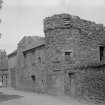Field Visit
Date 19 July 1913
Event ID 1087312
Category Recording
Type Field Visit
Permalink http://canmore.org.uk/event/1087312
'Bothwell Castle'
The ruin of this town house, which dates from the late 16th or early 17th century, occupies a site on the left bank of the River Lyne 100 yards below the new bridge. It covers a considerable area, extending from the river bank to East Gate Street, which is the main access to the town from the east. Fig. 87 [RCAHMS 1924] shows the condition of the structure in 1897, while fig. 86 [SC 1127009], taken in 1913, shows its present state of ruin.
On plan the structure consisted of a main block running north and south parallel to the street and two wings; which extended eastwards to the river and enclosed a small courtyard. At the south-west angle of the frontage there projects a circular tower, in which was placed the main entrance. Above this is a weather worn armorial panel within the usual moulded border. The entrance in the tower has long been built up and superseded by a doorway more conveniently placed in the centre of the main block. This main block contained a sunk floor, two upper floors and an attic. The area is reached from the street level by a staircase within the tower, and it is probable that this stair originally continued upwards and gave access to the upper floors before the erection of a wide scale and platt staircase built out on the courtyard between the wings. The wings were three storeys high and were also served by this later staircase. At the eastern end of the south wing there was a rectangular dovecot, not detached but forming a portion of the main structure.
The walls are built of rubble with ashlar dressings. The window and door jambs are moulded in some instances, splayed in others. The interior of the building was finished with care and taste. A drawing dated 1897 and preserved in the National Art Survey of Scotland records the interior wood panelling of one room and the iron door-fittings.* These all appear to have been excellent examples of native craftsmanship. This structure, less than thirty years ago, was one of the best specimens of old Scottish domestic town architecture.
RCAHMS 1924, visited 19 July 1913.
*[HES hold a copy as ELD 58/1]







